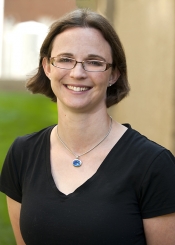By Erinn Aspinall
Library instruction at the Bio-Medical Library has undergone an important transformation over the last few years.
Gone are the days when stand-alone classes were offered on a single resource. Today’s Instruction Services offer personalized courses brought to you by the library’s best resource – its librarians.
Looking back
Just a few years ago, the Bio-Medical Library offered curriculum support through course-integrated instruction as well as stand-alone workshops on library resources.
The stand-alone workshop model is followed by most libraries to this day, but this approach did not meet the needs of the Academic Health Center.
Liz Weinfurter, Nursing Liaison and Instruction Coordinator, was part of this analysis. “We looked at attendance statistics and consulted with library staff involved with instruction,” said Weinfurter. “We stopped offering this type of library-sponsored workshops for a semester to see if it brought up any issues,” she said. “It didn’t, so we decided to rethink our approach to library instruction.”
New model for instruction
Stepping away from the traditional library instruction model provided opportunities for Bio-Medical librarians to more fully engage with the teaching mission of the University of Minnesota Academic Health Center.
Library staff were freed to invest additional time in course-integrated instruction, which offers training that is tailored to the course curriculum and to student needs. This allowed librarians to teach in the classroom where they could provide high-touch instruction at the point of need.
Weinfurter summarizes this new instructional model as follows: “It boils down to providing what students need to know, when they need to know it – the right information at the right time in the right place,” she says.
Integrated instruction provides best outcomes
The Bio-Medical Library’s course-integrated instruction is guided by a set of core information competencies for health professionals that can be directly tied to the goals of the course.
“Everything we do is for a reason,” says Weinfurter. This includes working with faculty to customize library orientations, providing instruction during class time that meets project-specific needs, and developing personalized resource pages for students that highlight relevant information. The result is a more engaging and meaningful experience.
Library instruction as part of the Family Medicine Clerkship
Students enrolled in the Family Medicine Clerkship have felt the value of course-integrated instruction directly. In this small lecture setting, librarians Jim Beattie and Jonathan Koffel support an evidence-based medicine assignment.
David Power, Director of the Family Medicine Clerkship, and David Frenz, the course’s evidence-based medicine instructor, have worked closely with Beattie and Koffel for several years.
“Since we implemented an Evidence-Based Medicine project in the Family Medicine Clerkship (previously Primary Care Clerkship) over 10 years ago, our Bio-Medical librarian colleagues have played a pivotal role,” says Power. “Every 4 weeks librarians assist clerkship students refine their clinical question, effectively search for the evidence to answer it, and evaluate the students’ ability to finally communicate their findings – both in medical jargon to their peers and in plain language to a patient,” he adds.
Beattie, working alongside Koffel, takes very hands-on approach when teaching students in the course. “I help students answer questions, provide search tips, and offer one-on-one help,” Beattie says. At the end of the clerkship, students will have located information to present their case. More importantly, students will have gained life-long skills to support evidence-based practice.
What is the value of Beattie’s and Koffel’s contribution? “Health sciences librarians help me – and our students – find good evidence fast at the point-of-care,” says Frenz. Power echoes this sentiment stating, “In short, we could not run this project without our librarians.”
Librarians add value
The Bio-Medical Library offers an extensive collection that supports the information needs of the Academic Health Center. The collection’s value can be measured, in part, by its use. This is why librarians who help students discover, understand, and apply information are a library’s best resource.
“Our Instruction Services show that librarians are an important part of the teaching team and of the education process,” says Weinfurter. “The library isn’t just a place, but people with a skill set that can be utilized to increase students’ understanding and skills,” she says.
More Information
Bio-Medical Library, Instruction Services Website
Liz Weinfurter
eweinfur@umn.edu
(612) 624-6492





